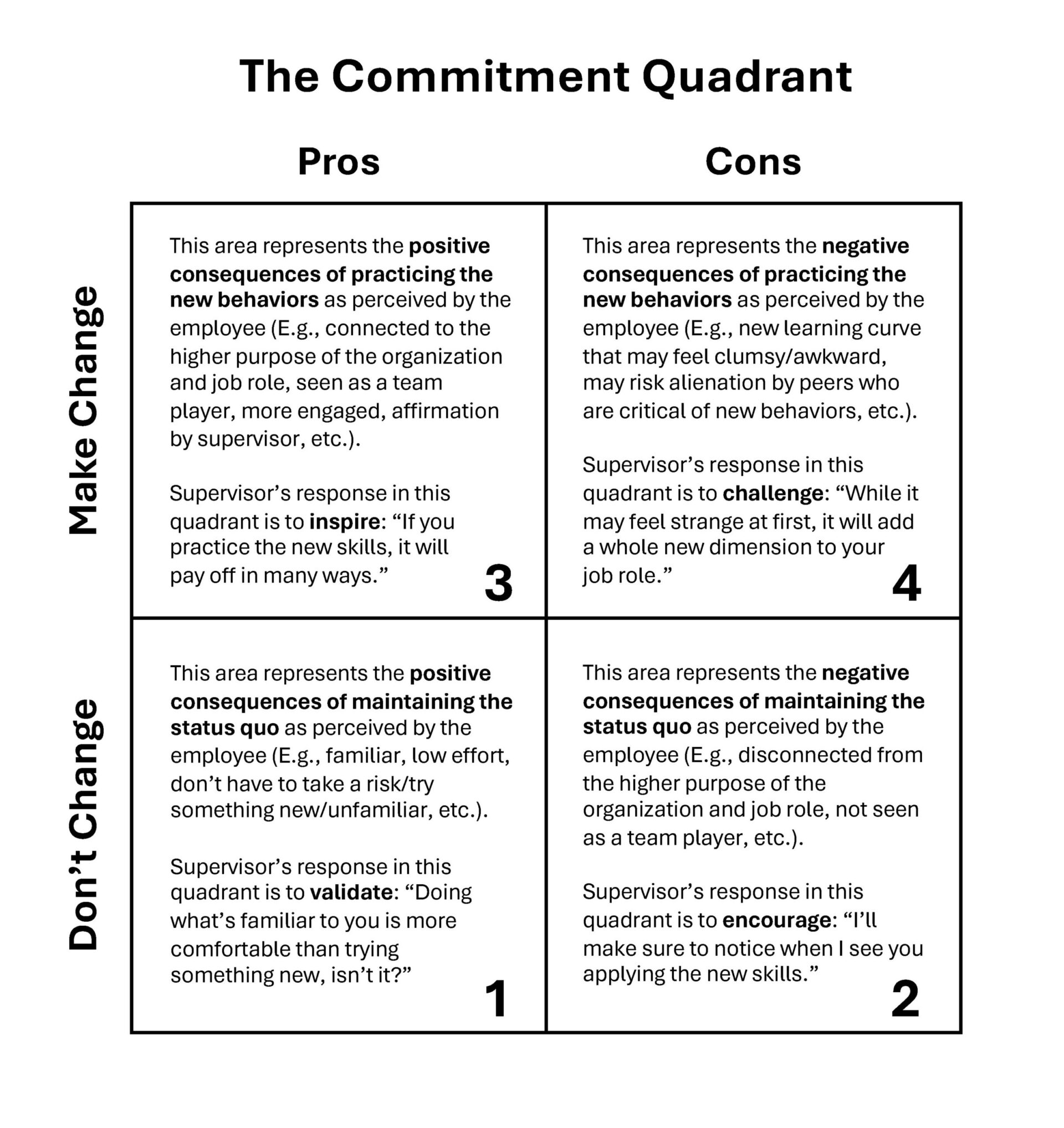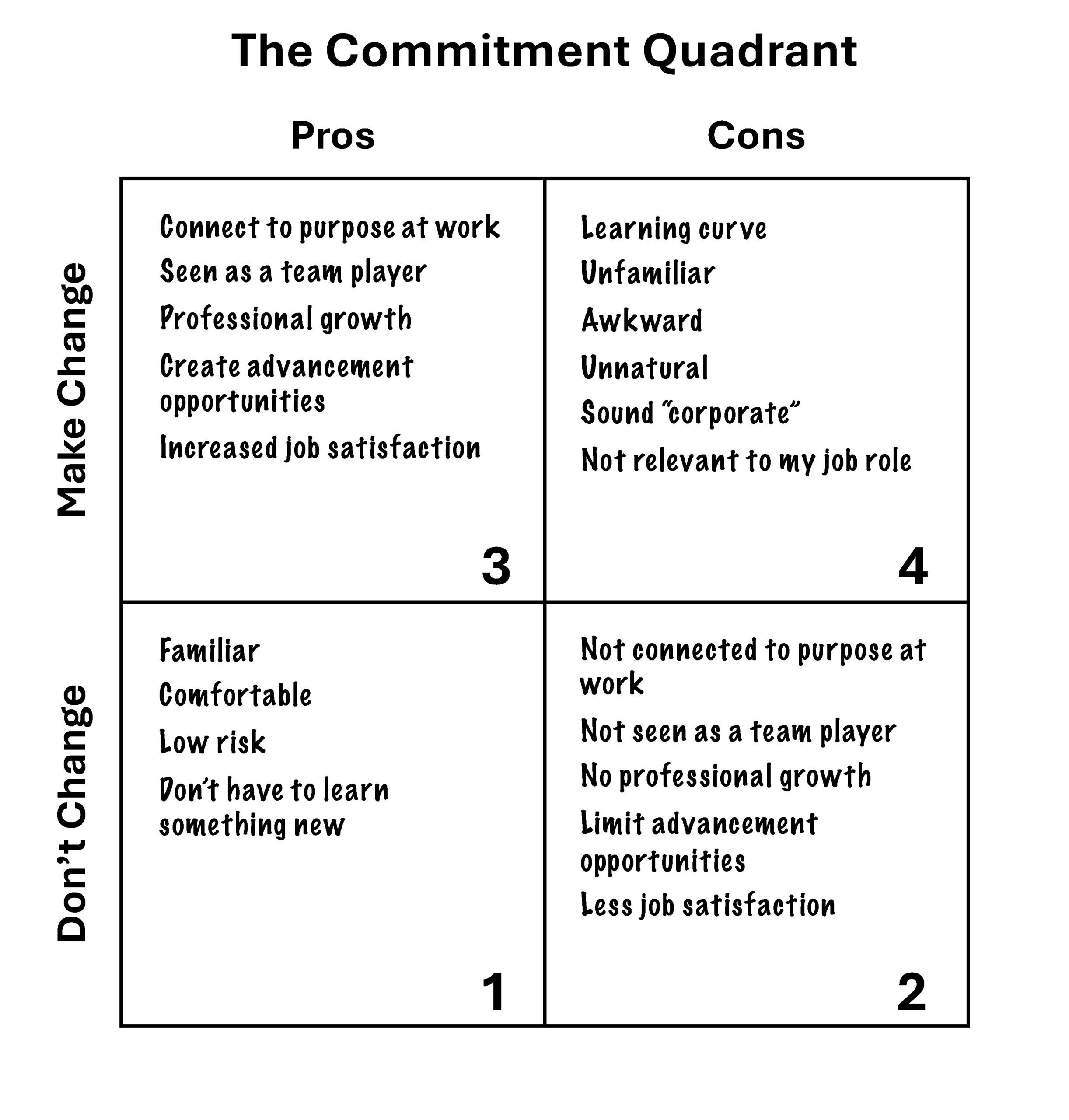Whenever I present to managers about articulating and revealing guiding statements, organizational purpose, or core values to frontline staff and connecting them to their daily work activities, I get the question, “What if they don’t buy in to these corporate ideals?”
Now, you might ask, “Why on earth would they not buy in to them? And why wouldn’t they jump at the chance to reflect the higher purpose of their job role at work?”
Here’s why:
- Most of these types of corporate initiatives are viewed cynically by frontline employees as flavors of the month that will become irrelevant in a matter of weeks.
- Most guiding statements are viewed as amorphous and removed from employees’ real world of work.
- Most lists of core values are seen as imitative or performative.
- It requires real effort to apply new skills leading to behavior change.
- It requires consistent collective effort from all team members to change the culture.
- Most employees recognize the difference between stated priorties (reflect the higher purpose of your job role, reference core values in decision-making, etc.) and real priorities (hit sales targets, reduce expenses, reach profit goals, etc.).
So, employees’ skepticism is justified. As a supervisor, manager, or leader, it’s your responsibility to gain employees’ commitment. This can be done in a variety of ways linked to performance management including feedback, coaching, and modeling, but it’s not easy.
Years ago, a colleague and I were discussing this dilemma when he opened a notebook and drew a large square divided into four quadrants, labeling the y-axis “Don’t Change” and “Make Change” and the x-axis “Pros” and Cons,” numbering them in ascending order from 1-4. He titled this model “The Commitment Quadrant.”
As a psychologist, he’s had extensive training in human motivation theory. He said that if supervisors would just take a few minutes and pose a simple set of follow-up questions to employees after their participation in a meeting or training class that introduced a new corporate initiative or set of skills, they would almost certainly increase buy-in and realize observable/quantifiable benefits.
Supervisors, managers, and leaders are often spread thin. Expecting them to embrace any form of follow up to a meeting or training class may seem daunting. Even so, almost everyone would agree that follow up is beneficial. The reason most structured follow-up measures are met with resistance—and limited success—is because they are seen as too time consuming and involved, where the costs of time and effort outweigh the perceived benefits.
 The Commitment Quadrant requires 10-15 minutes for a supervisor to follow up with her direct report and informally address each of the four questions listed below. It is vital that employees actually write their responses in the corresponding quadrants as each question is addressed. Just thinking about it or discussing it will not have the same powerful effect as writing it down. It is also imperative to follow the prescribed order from 1-4. Begin with “pros of no change” because it represents current behavior, followed by “cons of no change,” followed by “pros of change,” and ending with “cons of change” because it is the most threatening to the employee.
The Commitment Quadrant requires 10-15 minutes for a supervisor to follow up with her direct report and informally address each of the four questions listed below. It is vital that employees actually write their responses in the corresponding quadrants as each question is addressed. Just thinking about it or discussing it will not have the same powerful effect as writing it down. It is also imperative to follow the prescribed order from 1-4. Begin with “pros of no change” because it represents current behavior, followed by “cons of no change,” followed by “pros of change,” and ending with “cons of change” because it is the most threatening to the employee.
As it relates to a training class about articulating and revealing corporate ideals to frontline staff and connecting them to their daily work assignments, you might say:
“Based on the training class you attended,
1. What are some potential positive consequences of NOT applying the new skills in your job role?” (E.g., not reflecting the higher purpose of your job role, not referencing core values in decision-making, not joining in the collective pursuit of a common aspirational goal, etc.)
This question may seem counterproductive, but the reality is that employees are keenly aware of the validity of these benefits and many supervisors fail to acknowledge them as valid.
2. “Now, what are some potential negative consequences of choosing NOT to apply the new skills in your role?”
This question serves to address negative consequences that often are not discussed.
3. “What are some potential positive consequences of applying the new skills in your role?”
This question serves to support an employee’s desire for gain.
4. And finally, “What are some potential negative consequences of choosing to apply the new skills in your role?”
This question serves to assuage an employee’s fear of loss. Like the first question, this may appear counterproductive but, again, employees are aware of the validity of negative consequences while many supervisors underestimate them, dismiss them entirely, or don’t believe they apply to their work groups.
 The act of simply filling in these boxes in the order prescribed, with no further training or intervention, has led to significant behavioral changes in a variety of clinical studies involving weight loss, smoking cessation, sunscreen application, contraceptive use, etc.
The act of simply filling in these boxes in the order prescribed, with no further training or intervention, has led to significant behavioral changes in a variety of clinical studies involving weight loss, smoking cessation, sunscreen application, contraceptive use, etc.
So, if you detect skepticism from staff related to embracing corporate ideals, practicing new skills, using new technology, or another important work priority or initiative, consider applying The Commitment Quadrant. It’s structured, requires little time or preparation, and offers the immediate benefits of increased buy-in, reinforcement and retention of priorities, clarification of expectations, potential disclosures of fears or apprehensions, and positive behavioral change.
And, perhaps most importantly, it creates an opportunity for a one-on-one conversation that supports individual and team success.



